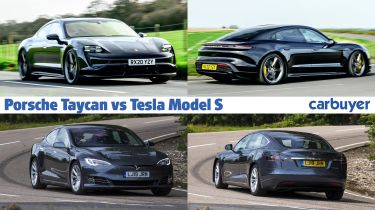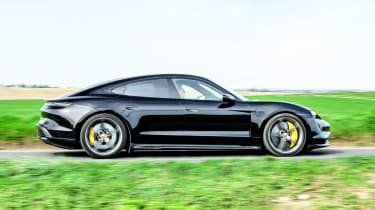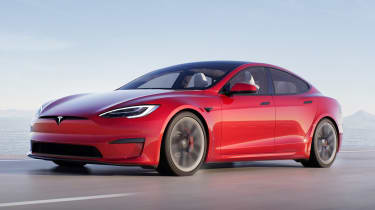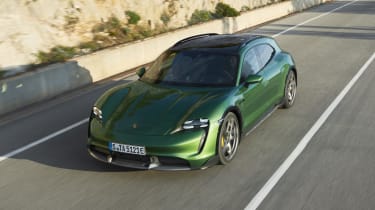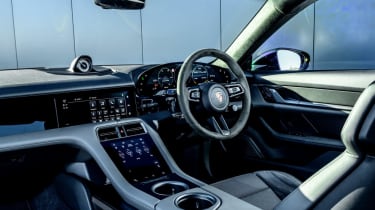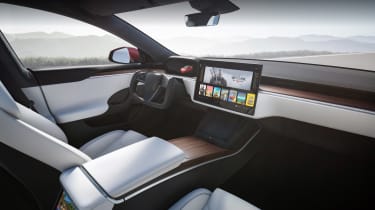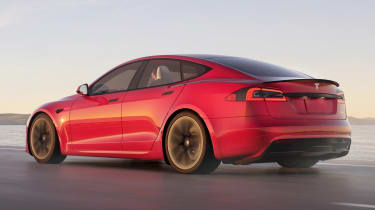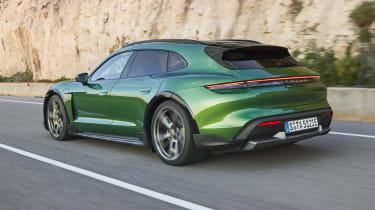Porsche Taycan vs Tesla Model S: rivals comparison
The Porsche Taycan is the closest rival to the Tesla Model S but which of these fast, luxurious, electric cars is the best?
It’s fair to say that the Tesla Model S drastically changed the electric car market when it was launched, as the EVs before it tended to be slow and have limited range. The Model S is a sleek, near-silent saloon that has the performance to scare the fastest supercars and the range to make it the car you use for every journey.
The Porsche Taycan had a lengthy development period to make sure it could live up to the badge on its bonnet, and it’s been worth the wait. Initially, only the fastest Turbo and Turbo S models were available; now, there are rear-drive and 4S models, which offer nearly as much performance but for lower prices. A new Cross Turismo estate version of the Taycan was unveiled for 2021 and is set to arrive in summer. Available in the 4, 4S, Turbo and Turbo S trim levels, it’s a more practical version of the standard model with increased ground clearance, bodywork protection and a more spacious interior.
 The 10 best electric cars in 2025
The 10 best electric cars in 2025
Both are highly impressive and futuristic; read on to see which you should buy. Once you’re done, check out our guide to the fastest saloon cars.
Price
The Porsche Taycan was much more expensive than the Tesla Model S when it launched because the Turbo and Turbo S models cost around £116,000 and £139,000 respectively. With the introduction of the 4S and the new entry-level model, the Taycan starts at a lot less; at just over £70,000, the unnamed rear-wheel-drive version is nearly half the price of the flagship model. Impressively, its starting price essentially matches that of the Porsche Panamera, and you’ll enjoy much cheaper running costs if you buy a Taycan.
The Cross Turismo, meanwhile, is available in four different forms, with prices for the entry-level ‘4’ starting at £79,340 and increasing to £139,910 for the flagship Turbo S. The Cross Turismo is only available with four-wheel drive and the larger 93.4kWh battery. For the moment, it’s one of a kind in offering high-end electric performance in estate guise, with its closest rivals, the Audi RS6 and Mercedes-AMG E63 estate, both powered by thirsty petrol engines.
The Tesla S Long Range starts at just under £84,000 and has been joined by two new Plaid variants. The standard Plaid model costs £111,000, before options, and it’s a further £20,000 for the Plaid+ model, which has an even better range. Tesla seems to change its pricing regularly, which in turn makes it harder to predict monthly payments if you’re buying these cars on finance deals.
Powertrain and performance
Underpinning the Porsche and the Tesla are skateboard-style chassis, with the battery packs filling the space between the axles. Both cars have electric motors on each axle, making them all-wheel drive, although a rear-wheel drive, single-motor configuration powers the new entry-level Taycan.
The Taycan uses a 93.4kWh battery and an 800V system, and produces 617bhp as standard in both Turbo and Turbo S models. Enable launch control and the output increases to 671 and 750bhp respectively. Turbo models are capable of 0-62mph in 3.2 seconds and Turbo S versions drop the time to 2.8 seconds - both are electronically limited to a 161mph top speed. Porsche did 26 consecutive launches during testing, showing that the car can repeatedly perform. The Taycan also set a new Nurburgring lap record for a fully electric four-door saloon, completing the circuit in 7:42. Even the base model hits 0-62mph in 5.4 seconds, which is still very quick.
The base 4 Cross Turismo, meanwhile, is powered by the same 93.4kWh battery and has an output of 375bhp. When using the car’s launch control system, overboost increases power to 469bhp and 0-62mph takes 5.1 seconds. The 616bhp Turbo model is even quicker, with 671bhp on overboost for a 0-62mph time of 3.3 seconds and a range of up to 281 miles. The flagship Turbo S offers the same 616bhp power output but gets an increased overboost figure of 751bhp for a 0-62mph time of 2.9 seconds.
Since Tesla simplified the Model S range, all three available models use a 100kWh battery and acceleration from 0-62mph takes just 3.1 seconds in the Long Range model. The Plaid and Plaid+ variants, meanwhile, incorporate three electric motors and their 1,006bhp power output means the Model S can reach 0-60mph in just two seconds. The Plaid+ uses the latest in Tesla battery technology to deliver more range than the standard Plaid model.
Charging times and range
On a full charge, Porsche says the Taycan manages up to 300 miles if you choose the base model with the optional bigger battery, and 257 miles on the top-of-the-range Turbo S. For the entry-level 4 Cross Turismo, range figures are very similar. Porsche claims a range of up to 283 miles, while figures are lowered only slightly for the 4S and 4S Turbo models at 281 miles. The Turbo S model, meanwhile, has a range of 260 miles. Porsche has future-proofed its first electric car; it’s compatible with chargers that offer up to 270kW, even though very few chargers currently offer this. On a 270kW charger, the Taycan’s battery level can jump from 5% to 80% in just 23 minutes, while using a 50kW charger increases the waiting time to 93 minutes. An 11kW wallbox is available, which recharges the Taycan in nine hours.
 Best electric car charging stations 2024: owners rate their top 9 networks
Best electric car charging stations 2024: owners rate their top 9 networks
The Tesla Model S has always been ahead of its competitors in terms of range, and even the Plaid version manages up to 390 miles, although European figures might be slightly different. The Long Range version offers an extra 22 miles of range but is considerably less expensive. The Plaid+, meanwhile, is said to achieve the highest range of any electric car, with more than 520 miles of range, which would be absolutely remarkable if accurate in the real world. Tesla’s newest Superchargers provide up to 200kW of power, meaning a top-up to 80% takes 45 minutes.
Exterior design
Treading the line between traditional and modern, the Porsche Taycan looks like current Porsches yet has futuristic styling to match its powertrain. It’s the company’s first electric car, and its design indicates that it’ll slot in below the Porsche Panamera in size, if not price. The window shape is similar to the Panamera and the 911, and the Taycan is as sleek and smooth-looking as you might expect. There are eye-catching design touches, like the four-dot LED headlights and the full-width tail-light bar, and its 21-inch alloy wheels are similar to those fitted to the Mission E concept car.
The Taycan Cross Turismo shares its styling with the Taycan saloon and incorporates the roofline of the Porsche Panamera Sport Turismo. Additional black and silver bodywork cladding tells them apart, plus a 20mm raised ride height, which makes it smoother and more manageable on uneven road surfaces.
Tesla’s offering looks more like a regular saloon, which makes its performance all the more surprising. Since being facelifted, the Model S has quite a blank nose, punctuated by a thin grille and slim LED headlights. It adds luxury touches like door handles that glide out when you approach the car. Its 21-inch wheels are a costly optional extra on the Performance model.
Interior design
Porsche has aimed to blend old-school and ultra-modern inside the Taycan. The dashboard design apes the Porsche 911’s, which is designed to resemble the original 911’s dash, but adds plenty of technology - and touchscreens. There’s a 10.9-inch infotainment screen, an 8.4-inch screen on the lower centre console, a huge virtual instrument cluster and the option of a separate touchscreen for the passenger. If specified, the two screens combine to look like one massive display. Five interior colours are available, and you can choose between leather or sustainable microfibre upholstery.
Inside, the Taycan Cross Turismo is almost identical to the standard Taycan. It features the same freestanding digital instrument cluster and a 10.9-inch infotainment display. There is an optional display screen available for the passenger. An optional Off-Road Design package is also available.
Tesla’s Model S interior is dominated by an enormous 17-inch tablet-like portrait touchscreen, which can be tilted left and right, and can be used as both an infotainment screen and a games console. We expect the games console option won’t be available while the car is in ‘drive’ mode, however. Whereas the Taycan has different screens for different features, almost everything is controlled through one screen in the Model S. Which you like most comes down to personal preference but neither have physical buttons for the climate control, which would make it easier to use. The interior is clad in leather, zinc and Californian wood, but you can spec finishes like carbon fibre at additional cost. Questions remain about the build quality of the Model S; the Porsche feels more solidly put together.
The Model S also features a new ‘Yoke’ steering wheel, which resembles the controls you’d expect to find for a pilot in an aeroplane. It’s been confirmed as legal but it will be interesting to see how easy it is to make a three-point turn with what is effectively half a steering wheel. It no longer features the standard stalks behind the wheel, either, with all the indicator and wiper functions now integrated as touch-sensitive controls within the steering wheel. The view to the newly fitted digital instrument cluster is also uninterrupted, thanks to the removal of the top half of the steering wheel.
Technology
These are flagship electric cars, so both feature an impressive array of technology. In the Taycan there’s online connectivity, over-the-air software updates, a night-vision system that can detect objects and animals further than the reach of its headlights, plus a range of safety tech. There’s also a semi-autonomous driving capability that essentially allows the Taycan to drive itself on the motorway, although it’ll never be fully autonomous - it’s still a Porsche, after all.
Tesla’s technology is mostly channelled through that large touchscreen. Using Google Maps means the sat nav is instantly familiar and has up-to-date traffic info, while you can add apps like Spotify and a calendar to the tablet-like screen. The Tesla comes with a whole suite of safety technology, plus the option of ‘full’ self-driving if it’s legal where you live (it isn’t in the UK). When you ask it to, the Model S can drive, change lanes and even park itself. Other equipment includes powered front seats, all heated seats, a glass roof and a heated steering wheel.
The Model S gains a second screen in the back of the front armrest, which rear passengers can watch TV or play games on when the car is both stationary and moving. Other tech includes Bluetooth connectivity for multiple devices and a 22-speaker stereo with active noise cancelling. Front and rear passengers both get access to a pair of wireless phone charging pads too.
Practicality
While you don’t buy a car like this for its luggage space, both do quite well for people and cargo. There’s plenty of space for four adults inside the Taycan, and the rear seats offer plenty of legroom for even your tallest friends. The svelte coupe shape means that some will find headroom a bit cramped, though. Plus, while there is a fifth seat, it’s only suitable for very short journeys as it’s far narrower than the other two rear seats. The main boot space measures 366 litres - nine litres shy of a Mercedes A-Class - and there’s an extra 81 litres under the bonnet.
The Taycan Cross Turismo has a higher roofline, however, which improves practicality. Porsche claims it offers 47mm more headroom for rear passengers. The 4 and 4S models offes a 446-litre boot with the rear seats in place, which expands to 1,212 litres with them folded flat. The Turbo and Turbo S models have a slightly smaller 405-litre boot, with 1,171 litres available with the rear seats folded down.
The Taycan’s figures aren’t so impressive when you look at the space available in the Model S. It offers class-leading room for rear-seat occupants, and there’s a good-sized middle seat with plenty of foot room too. There are a number of storage cubbies dotted around but you might not need them, as the boot is massive. You’ll have almost 750 litres to fill with the seats up - that’s more than a Mercedes E-Class Estate, and more than double the Taycan - and there’s up to 150 litres more in the front trunk. Seats down, you’ll have 1,795 litres of space. The Model S features a redesigned second row of seats, too, which means there’s extra leg and headroom.
Safety
You could argue that these cars are at the cutting edge of automotive development, so it’s no surprise that there’s a vast amount of technology on board to keep you safe. The Taycan got a full five-star safety rating from Euro NCAP in 2019. Porsche’s optional InnoDrive self-driving system combines lane-keeping assist, overtaking assist, radar-guided cruise control and stop-and-go, and there’s also a night-vision system, auto emergency braking, collision avoidance assistance and rear cross-traffic alert.
The Model S has picked up glowing safety scores in Europe and America. In fact, in a US roof strength test, the Tesla broke the crushing machine; it’s strong enough that you could put four cars on the roof and it wouldn’t cave in. As well as the optional Autopilot system, which costs over £3,000 and delivers a similar level of autonomous driving to the Porsche, the Tesla features lane-departure warning and speed assistance.
Verdict
While one of these is made by a Californian tech company and the other is built by a sports car manufacturer with decades of experience and VW Group backing, the Taycan and Model S are fairly well-matched. If you only look at the numbers, the Tesla would impress you most - it’s quicker, especially with the Plaid powertrain, more practical and offers a much longer range - but there are still doubts over its build quality. Tesla seems to continuously change its pricing (in 2019, it slashed the price of the Model S by as much as £48,000), which worries some potential customers and makes monthly finance payments more expensive.
Porsche has created a fantastic car in the Taycan, and we’re not surprised to learn that it’s now the brand’s best-selling car after the Porsche Macan SUV. Even without a petrol engine, the Taycan feels just like any other Porsche but it will also beat most of the others in a drag race. With the new rear-wheel drive model now on sale, and the slightly larger and more powerful Cross Turismo estate, we think the Taycan is even easier to recommend. It’s a better car than the Model S but not by much.
For other eco-friendly cars that are good to drive, read our guide to the best hybrid and electric sports cars.
Recommended

New Subaru Trailseeker revealed as rugged electric SUV with 375bhp

New Subaru Solterra brings more range, power and polish
Most Popular
Tips & advice

Car dashboard warning lights: what does each symbol mean?

Electric car charging stations: public networks, charger types, apps and maps


